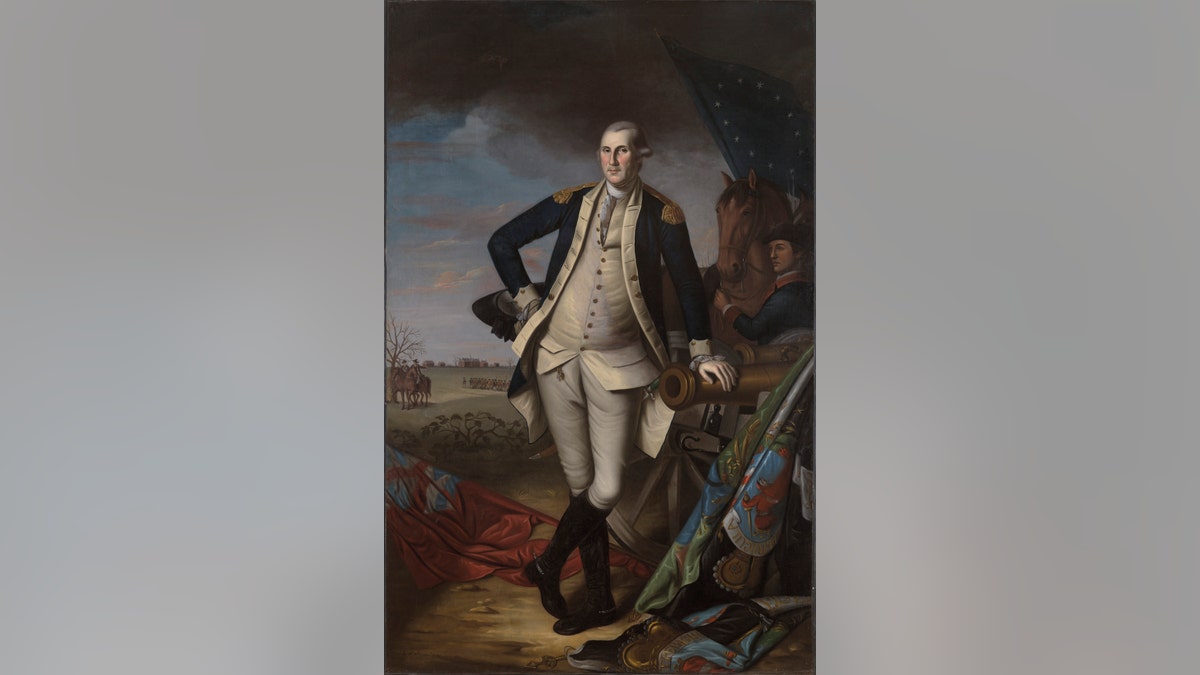
Washington’s sash displayed alongside Peale’s 1776 portrait of Washington. (Courtesy of the Museum of the American Revolution)
The storied blue sash worn by George Washington during the Revolutionary War has gone on display at Philadelphia’s Museum of the American Revolution.
The sash, on loan from Harvard’s Peabody Museum of Archaeology & Ethnology, was rediscovered several years ago by Dr. Philip Mead, chief historian and director of curatorial affairs at the Museum of the American Revolution. Mead found the artifact at the Peabody Museum, where it had essentially been hidden in plain sight for decades. Although the sash was suspected to have belonged to Washington, it had never been confirmed, according to the Museum of the American Revolution.
"I was amazed. I thought, could this really be the sash that Washington wore on the early battlefields of the Revolutionary War?” Mead told Fox News, via email. “Where has it been all these years? The truth was even more exciting than I dared to hope.”
FROM ROYAL STATUE TO REVOLUTIONARY WAR BATTLE: THE AMAZING JOURNEY OF 'MELTED MAJESTY' MUSKET BALL
Mead spent years studying the sash before concluding that it was indeed the one worn by Washington.
The sash, which is on display until Oct. 9, is featured with a 1776 portrait of Washington by Philadelphia artist Charles Willson Peale, which depicts him wearing the sash. The portrait is on loan from the Brooklyn Museum.
The Museum of the American Revolution notes that when Washington first took command of the Continental Army in 1775 there was no standard uniform or insignia for officers. The new Commander-in-Chief needed something to distinguish himself from his fellow officers so he chose a blue silk sash, or ribbon, that he wore across his chest.
SOLDIER’S FAITH: RARE BIBLE CARRIED AT THE BATTLE OF BUNKER HILL HAS MOVING INSCRIPTIONS
In a statement, Mead noted that very few uniforms from the American Revolutionary War have survived, let alone pieces of Washington’s own military clothing. “Being in the presence of this sash that Washington wore during the heavy fighting of 1775-1779 is astounding,” he added.
The expert said that the sash literally disappears from later paintings of Washington after the general decided that it too closely resembled monarchical symbols of power. Notably, in Peale’s painting ‘George Washington at the battle of Princeton,' which is in the collection of the Yale University Art Gallery, the outline of the painted-out sash can clearly be seen. The 1781 painting is one of a number of replicas produced by Peale of a portrait he painted of Washington in 1779 to commemorate the Continental Army's victories in Trenton and Princeton, New Jersey.

(Yale University Art Gallery)
After the sash is removed from the Museum of the American Revolution's display in October, it will be replaced with a sword that belonged to Washington, on loan from a private lender. The sword, which was made in Philadelphia and used during the early years of the Revolutionary War, will go on display Oct. 10 alongside a 1778 hand-painted copy of the portrait currently on display at the museum.
ARCHAEOLOGISTS UNEARTH HISTORICAL TREASURE TROVE FROM 300-YEAR-OLD PHILADELPHIA TOILETS
The discovery of Revolutionary War era artifacts offers a fascinating glimpse into the events that shaped America. A storied Revolutionary War musket ball that was melted from a famously toppled statue of King George III, for example, recently went on display at the Museum of the American Revolution.
Earlier this month, a Revolutionary War-era knife was unearthed during an archaeological dig at Colonial Michilimackinac in Mackinaw City, Michigan, the latest in a series of amazing finds at the site.
Follow James Rogers on Twitter @jamesjrogers